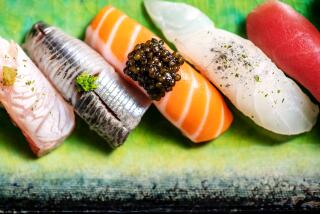Soup to Beat the Heat
- Share via
The way Sean Hardy, executive chef at the Peninsula Beverly Hills hotel, figures it, his staff shells more than $20 worth of green almonds to coax just a cup of milky white paste from the embryonic nut.
That would suggest green almonds are the caviar of the nut family. It also might explain why, since having Hardy’s white gazpacho soup several nights previously, I felt compelled to track him to his chef’s lair and buttonhole him for the recipe. With the soup’s subtle flavors of almond and green grapes, I was convinced that I had found the perfect dish to get me through those stultifying August evenings.
It wasn’t to be.
“You had the last of it. It’s available for about eight weeks--from mid-April to mid-June--and when it’s over, it’s over,” Hardy snaps with gruff Yankee finality. I’m not taking it personally. We’re standing in the middle of the Peninsula kitchens, where the Boston native oversees every dish handled by his 35-person staff like a Parris Island drill sergeant. Who’s got time for gentle conversation?
Still, Hardy, who was executive sous chef under Bill Bracken for three years before ascending to the top job a few months ago, eventually softens under my pleading suggestion that substituting mature toasted almonds might lead to a similar result. My motives are transparent: It’s like finding out the woman you’re smitten with is unavailable, and then hoping she has a sister.
Hardy leads me to an industrial-sized blender where he has assembled bowls of the soup’s key ingredients: diced and seeded English cucumbers, green grapes, lightly toasted and sliced almonds, salt, pepper, sherry vinegar and half-and-half. Off to the side is one of the hotel’s signature soup bowls, which looks like a white ceramic version of a banana-split dish. In the center sits an ice cream scoop-sized mound of peekytoe crab salad. Chicago chef Charlie Trotter was one of the first to popularize the sweet and subtle meat of the Maine peekytoe, which had been neglected because it wasn’t considered aesthetically pleasing (as if there’s such a thing as a handsome crab).
“I first came across this recipe as a sauce for fish,” says Hardy, flipping on the blender, which sounds like a B-52 readying for takeoff. “I have no idea when or how I started thinking of it as a soup. It’s just one of those things that happens all the time to chefs--where you’re looking at a bunch of different ingredients and then think to yourself, ‘Hey, what if I ... ?’ ”
As Hardy speaks, he dumps the ingredients into the blender with scarcely a look. At one point, he turns it off, tastes, adds a pinch of salt and a dash more sherry vinegar. He runs the blender again, stops it, tastes and, satisfied, pours the concoction through a fine mesh chinois. He then transfers the thin, pale green soup back into the blender, adds the half-and-half and turns on the machine for 30 seconds.
The frothy soup he dispenses around the mound of crab salad is now more white than green. Hardy garnishes it with slivered almonds, little square bits of cucumber and quartered grapes--red ones this time for contrast. Aside from chopping the soup ingredients and mixing the crab meat with mayonnaise and chives, the whole process has taken about six minutes.
He hands me the bowl.
The cool, refreshing, contrasting flavors are everything I remember from the time I tasted Hardy’s gazpacho: the sweetness of the grapes, the clean hint of cucumbers, the tang of the sherry vinegar and the sweet and salt of the crab. Added to this is a new taste--the smokiness of the toasted almonds. It works for me.
Tasting from his bowl, Hardy nods almost imperceptibly. “The difference between white gazpacho made with green almonds and these toasted almonds is like the difference in poaching a rib-eye steak in olive oil, or roasting a rib-eye with thyme and rosemary,” he says. “It’s subtlety versus big, bold flavors,” he adds, an 1/8-inch smile raising the corners of his mouth, “and this isn’t half bad.”
More to Read
Eat your way across L.A.
Get our weekly Tasting Notes newsletter for reviews, news and more.
You may occasionally receive promotional content from the Los Angeles Times.










